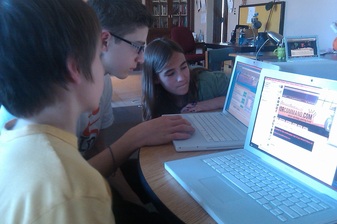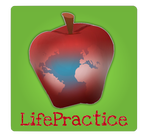
Recently, digging through older versions of our LifePractice PBL cards, I found a list of PBL guiding tips from a couple years ago that were never published. These were labeled as “foundation of PBL” but they seem to be just good reminders for a PBL classroom.
I know many teachers will be taking the upcoming summer months to reconsider how to integrate PBL into their teaching practices, so thought this might be a useful list, not as an end-all post, but more of a 9-point discussion-starter.
So let’s dig in!
1. When lesson planning, focus on a broader set of goals
How long will the project run? Identify the standards and skills you want emphasized. Are there other driving questions you’d like to add/substitute? Are you utilizing outside experts? Will you be the only teacher or are you teaming with other educators? How many students will be involved? Will you run this with your class only? Or will you team with other classes in the building? Outside of the building? Will you team across age/ability groups? Who are obvious leaders? Who are hidden leaders?
2. Considering project prep and work safety is also tops
Identify the area students will be using and secure the tools students will need to use. Identify any tool-safety workshops that will need to be taught. Be sure parents are informed of project scope and learning involved. Ensure all educators are clear with timeline and end results expected.
3. Launching a project doesn’t begin with a 100-question pre-test
Start with a “bang,” whether that is a question, conundrum, a challenge, or quest presented by a guest speaker or an engaging approach, depending upon the emphasized standards and driving questions selected.
4. Purposeful grouping is also something to deeply consider
You may choose to have multiple teams assigned the same role, creating multiple solutions to the same project, or you may choose to have different teams working on various roles to complete one version of the project. This is selected according to the class and according to the project and outcomes chosen by the lead teacher.
5. Ending the project isn’t geared toward prepping for the final test
Take pictures of students and teams with their work and pictures, showing proud faces. Evaluation: students share their learning, focusing on the learning and skills building and not simply what they did.
6. Assessment of learning is more than a multiple choice bubble test
Teachers may use rubrics to assess evidence of growth, based on standards and skills identified at onset of the project. Students might also self-assess and peer-assess their own learning and skills development, as well as engagement in the project and the information.
7. Post project wrap up? You mean we’re not finished with the final assessments?
Debrief with educator and student teams to create “wows/hows/bows” lists, purposefully identifying positive and incidental growth, as well as areas for whole-project improvement. This is a good time for students to build class community by focusing on the strengths and persistence of their peers and in their own work. This event is more about celebration of growth rather than celebration of accomplishments.
8. Role of the Teacher-As-Guide
Teachers should expect to ask more questions than have reason to give directions. This is more difficult than it seems. The majority of the teachers’ work is to be done before the project begins; once the project starts, this role shifts more to one of “advisor” for learning and less of “teacher” for content-delivery. We role model questioning, learning, patience, persistence, and growth. And as a guide, our number one roles are to be cheerleaders, encouraging kids as they move the right direction into being more an active “learner” and less a passive “student.” We admire and applaud the work they’re doing, and we guide deeper learning with customized questions.
9. Role of the Learner-as-Leader
As we’re working in our projects, we should allow, and even encourage students to experience leadership within peer groups. Encourage students with budding leadership skills to push themselves. Help the students highlight each others’ emerging strengths as part of the post project wrap-up.
I know many teachers will be taking the upcoming summer months to reconsider how to integrate PBL into their teaching practices, so thought this might be a useful list, not as an end-all post, but more of a 9-point discussion-starter.
So let’s dig in!
1. When lesson planning, focus on a broader set of goals
How long will the project run? Identify the standards and skills you want emphasized. Are there other driving questions you’d like to add/substitute? Are you utilizing outside experts? Will you be the only teacher or are you teaming with other educators? How many students will be involved? Will you run this with your class only? Or will you team with other classes in the building? Outside of the building? Will you team across age/ability groups? Who are obvious leaders? Who are hidden leaders?
2. Considering project prep and work safety is also tops
Identify the area students will be using and secure the tools students will need to use. Identify any tool-safety workshops that will need to be taught. Be sure parents are informed of project scope and learning involved. Ensure all educators are clear with timeline and end results expected.
3. Launching a project doesn’t begin with a 100-question pre-test
Start with a “bang,” whether that is a question, conundrum, a challenge, or quest presented by a guest speaker or an engaging approach, depending upon the emphasized standards and driving questions selected.
4. Purposeful grouping is also something to deeply consider
You may choose to have multiple teams assigned the same role, creating multiple solutions to the same project, or you may choose to have different teams working on various roles to complete one version of the project. This is selected according to the class and according to the project and outcomes chosen by the lead teacher.
5. Ending the project isn’t geared toward prepping for the final test
Take pictures of students and teams with their work and pictures, showing proud faces. Evaluation: students share their learning, focusing on the learning and skills building and not simply what they did.
6. Assessment of learning is more than a multiple choice bubble test
Teachers may use rubrics to assess evidence of growth, based on standards and skills identified at onset of the project. Students might also self-assess and peer-assess their own learning and skills development, as well as engagement in the project and the information.
7. Post project wrap up? You mean we’re not finished with the final assessments?
Debrief with educator and student teams to create “wows/hows/bows” lists, purposefully identifying positive and incidental growth, as well as areas for whole-project improvement. This is a good time for students to build class community by focusing on the strengths and persistence of their peers and in their own work. This event is more about celebration of growth rather than celebration of accomplishments.
8. Role of the Teacher-As-Guide
Teachers should expect to ask more questions than have reason to give directions. This is more difficult than it seems. The majority of the teachers’ work is to be done before the project begins; once the project starts, this role shifts more to one of “advisor” for learning and less of “teacher” for content-delivery. We role model questioning, learning, patience, persistence, and growth. And as a guide, our number one roles are to be cheerleaders, encouraging kids as they move the right direction into being more an active “learner” and less a passive “student.” We admire and applaud the work they’re doing, and we guide deeper learning with customized questions.
9. Role of the Learner-as-Leader
As we’re working in our projects, we should allow, and even encourage students to experience leadership within peer groups. Encourage students with budding leadership skills to push themselves. Help the students highlight each others’ emerging strengths as part of the post project wrap-up.


 RSS Feed
RSS Feed
